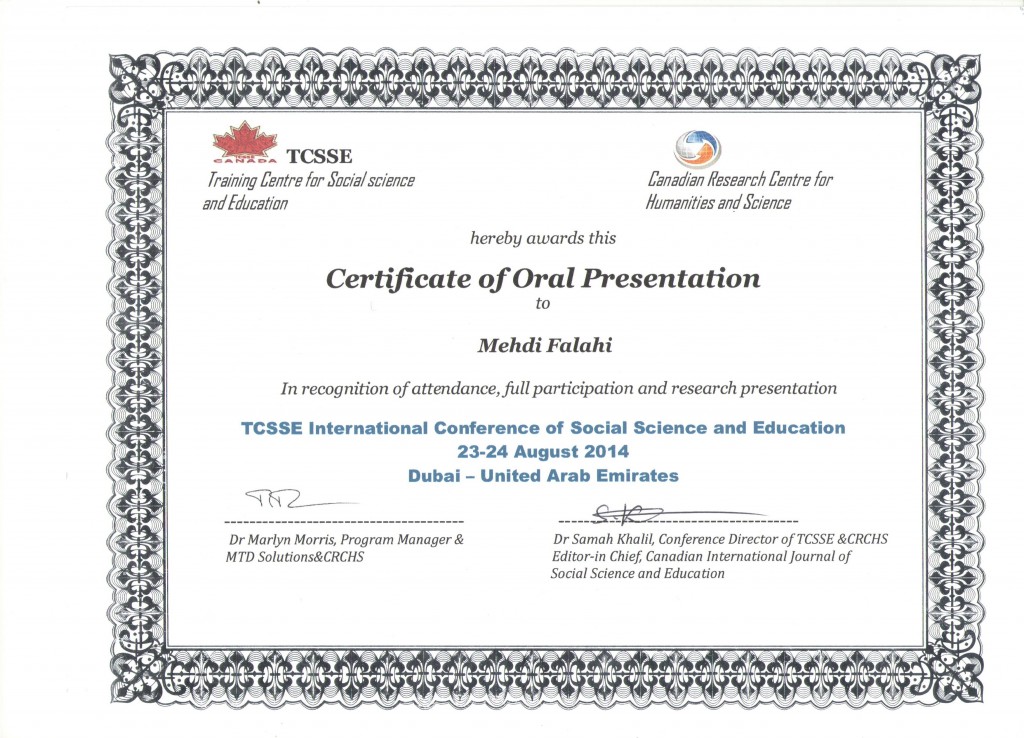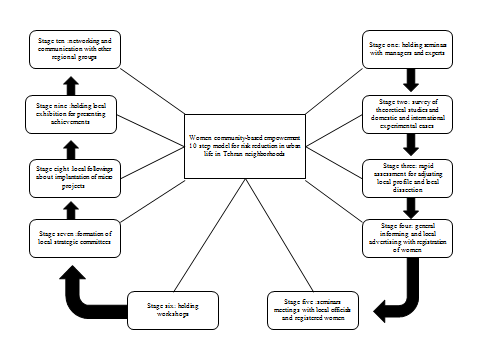مقاله پروژه تشکیل پایگاه های همیار خانواده با شعار محله بدون طلاق با رویکرد اجتماع محور، توسط تیم تسهیلگری و متخصصان مددکاری اجتماعی ،کلینیک مددکاری اجتماعی پونا انجام و نگارش شده است.
این مقاله سپس توسط تیم روابط بین الملل مجموعه به زبان انگلیسی ترجمه شد و برای کنفرانس بین المللی علوم اجتماعی و تحصیلات مرکز آموزش تحقیقات علوم انسانی کانادا ارسال گردید، پس از اخذ پذیرش برای ارائه پذیرش شفاهی در این کنفرانس، اعضای تیم در دبی در این کنفرانس حضور بهم رساندند ( آگوست 2014- دبی) و به ارائه این مقاله پرداختند و تجربیات موفق خود را در خصوص طرح های اجتماع محور با سایر متخصصان این رشته در سایر نقاط جهان به اشتراک گذاشتند.
Women’s Risk Reduction in urban life in Tehran neighborhoods with the community-based approach.
Medhi Fallahi, Pouna Social Work Clinic, NGO
Golshad Seif, Pouna Social Work Clinic, NGO
Mehdi Sarvi Hampa, Pouna Social Work Clinic, NGO
Pooneh Emam Shoushtari, Pouna Social Work Clinic, NGO
Abstract:
The scheme of women’s risk reduction in urban life in Tehran neighborhoods has been done by facilitation teams of Pouna social work clinic by using of the community-based empowerment 10-step model with the aim of identifying the risk status in neighborhood’s levels, standardizing of neighborhoods for women’s life, training of women for risk reduction and self-protection
expanding and leading women’s social contributions for reduction women’s risks.
Key words: hazards, risk, empowerment, community-based.
The issue & necessity of the scheme: Citizens, especially girls and women, daily experience different levels of hazards. The existence of compact settlements, increasing of risky behavior, the low coefficient of social belonging, are the most effective factors in creation and continuity of women’s risk backgrounds in urban life. NGOs and governmental organizations would be provided the possibility of hazards decreasing and community immunization for women in urban areas.
Method and The project model
In this section reviews the description and details of the scheme through this index
The first stage: before any proceeding, were held several meetings with managers and experts thereby firstly about the scheme were given necessary explanations, secondly received attendances suggestions & used previous
experiences in the scheme & finally expected outcomes and achievements of the scheme were reviewed
The second stage: In this stage the study team attempted to collect the existence literature about the hazard fields. After that rapid assessment questionnaire and observational forms of local profiles adjusted for using in the third stage
The third stage: In this stage inquiry teams with recourse to neighborhoods homes collected information. Then after inputting data in SPSS Software & analyzing data was set the report of local profile & based on findings of rapid assessment.
The fourth stage: In this stage the team of public relation of Pouna social Work Clinic attempted to provide and design posters and banners &
publishing articles in order to introduce the scheme and its benefits for families in local newspapers
The fifth stages: it was necessary that before the beginning of the scheme for motivating women and their local supporters were held seminars with registered women
The sixth stage: One of the features of community-based schemes is training women continually. Therefore after holding seminar sessions, during five consecutive weeks, women were trained in three-hour sessions, weekly
The seventh stage: In this stage, women groups must justify the responsible organizations about the group and its. So formed women groups with invitation of NGOs, local & governmental organizations held joint meetings in the neighborhood & presented their groups to them
The eighth stag: In this stage, women groups held weekly meetings & invited from members of facilitation teams as counselors
The ninth stage: The continuous depended on the continuous of training & empowering other neighborhood women. So in this stage, women groups held local exhibitions & exhibited their group achievements which had done in the form of local micro projects, publicly.
The tenth stage: Therefore in this stage, women formed groups communicated with other groups & shared their experiences. Finally this networking caused increasing capabilities and sources
Conclusions
In all societies different proceedings are done about women risk reduction. People participation & national commitment will be ensuring the continued of these proceedings.
In this regard, following suggestions are considered for greater effectiveness:
• Comprehensive support of formed groups for durability and increase of their life cycle.
• People’s participation through local micro projects in other social, cultural and economic issues
• Change the regard of management from higher to lower, to participation from lower to higher
• Avoiding of temporary proceedings and aggregation of all these proceedings in the form of community-based projects
• Media coverage of formed groups and their achievements for encouraging other society members.




